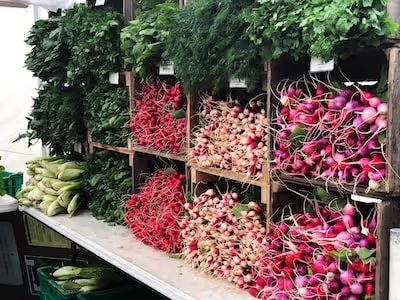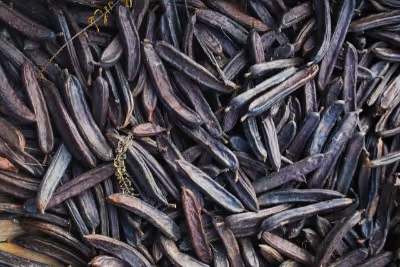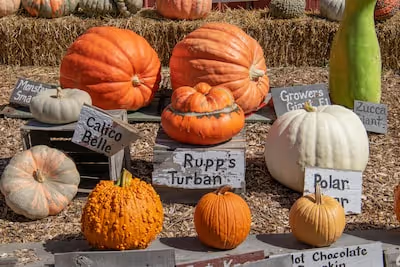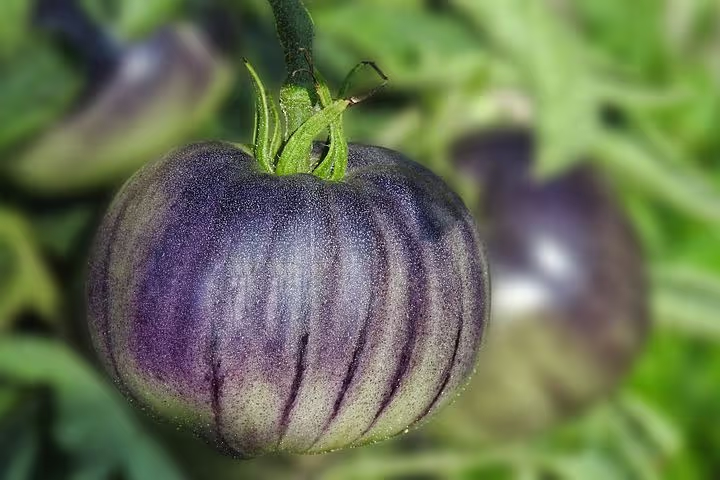Growing Celeriac: How to Plant, Grow, and Harvest at Home

Growing Celeriac
Growing celeriac rewards patient gardeners with a quirky root crop prized for hearty soups and velvety purées. Tackle growing celeriac by starting seeds indoors in early spring, transplanting into nutrient-rich soil, and watering consistently to cultivate generous roots. Keep reading to discover simple tips that'll turn your celeriac harvest from forgettable supermarket standby into spectacular kitchen staple.
Cheatsheet: Homegrown Celeriac Quick Guide
🌱 Sowing & Starting
- Start Indoors: Sow 10–12 weeks before last frost, 70°F/21°C.
- Use seed trays, cover lightly, keep moist.
- Transplant: Harden off after 6–10 weeks when 2–3 true leaves show.
🌤️ Site & Soil
- Full sun, loose, fertile, moisture-holding soil.
- pH: 6.0–7.0.
- Enrich with compost or aged manure.
🌾 Planting Out
- Transplant after frost, soil 50°F/10°C+.
- Space 8 in/20 cm apart in rows 15 in/38 cm apart.
- Set seedlings at same depth as trays, not deeper.
💧 Water & Care
- Keep soil evenly moist; avoid drought.
- Mulch to retain water, suppress weeds.
- Feed: Nitrogen-rich feed every 3–4 weeks.
- Remove lower leaves to expose the crown.
🍽️ Health & Yield Perks
- Rich in fiber, vitamin K, phosphorus, antioxidants.
- Excellent for self-sufficiency—stores up to 6 months.
- 1 plant yields 1 large root (avg. 1 lb/0.45 kg).
⏳ Harvest
- 180–200 days after sowing, when roots reach softball size.
- Lift with a fork; trim tops, rootlets.
- Store cool (35–40°F / 2–4°C), dark, and humid.
🧰 Tools and Products You'll Need
- Seed tray, spray bottle
- Trowel, garden fork
- Mulch, organic fertilizer
- Pruners, gloves
-
Growing Celeriac: How to Plant, Grow, and Harvest at Home
I grow celeriac for its clean, mineral bite that tastes like celery met hazelnut in a cool cellar. It is slow, steady, and worth every square foot.
Quick habit and flavor snapshot
Celeriac is a long-season, cool-loving root from the celery clan that forms a gnarled, aromatic knob at the soil line. The leaves are useful for stock, yet the swollen crown is the prize.
Season, site, and soil
Plant in full sun with steady moisture and a fertile, friable soil, pH 6.2 to 7.2. I aim for soil temps at 60 to 70 F, 16 to 21 C, and air temps that cruise between 50 and 75 F, 10 to 24 C.
Celeriac stalls in heat above 85 F, 29 C, and it sulks if roots dry out. Deep beds with compost and a pinch of wood ash for potassium grow sweeter bulbs.
Seed starting that actually works
Start seeds indoors 10 to 12 weeks before your last frost, since Growing Celeriac takes patience. Seeds need light to germinate, so press them onto the surface and mist rather than bury.
Germination takes 12 to 21 days at 70 to 75 F, 21 to 24 C. I drop temps to 60 F, 15 to 16 C, after emergence to build stocky seedlings.
- Use a fine seed-start mix, bottom-water, and keep humidity high.
- Thou shalt thin. One seedling per cell saves you from stringy, tangled starts.
- A gentle fan prevents damping-off and toughens stems.
“Start celeriac indoors in late winter, keep seeds on the surface for light, and expect a long germination window.” RHS growing advice
Transplanting and spacing
Harden off for 7 to 10 days, then transplant after nights stay above 45 F, 7 C. Set plants 10 inches apart, 25 cm, in rows 14 to 18 inches, 35 to 45 cm.
Plant at the same depth as in the cell. Burying the crown slows swelling, which defeats the point.
Water and feeding rhythm
Water 1 to 1.5 inches per week, 25 to 38 mm, more in sandy soils. I mulch with straw at 2 inches, 5 cm, to lock in moisture and keep crowns clean.
Side-dress with compost at 30 and 60 days after transplant. Use a low-nitrogen, higher-potassium feed, something near a 3-4-6 pattern, to fatten roots without making hairy side growth.
Pro moves for fat, clean bulbs
- Gently brush soil from the crown midseason to expose the shoulder to light.
- Trim a few outer leaf stalks as they yellow, which tidies the crown and reduces rot.
- Snip off spidery side roots near the surface two or three times late summer to push energy into the main bulb.
Climate workarounds
In hot regions, start early and plant where afternoons get light shade. In cold regions, use black plastic or landscape fabric to warm soil and a low tunnel to buy a month on each end.
Pests and disease, handled
- Leaf miners create squiggles in foliage. Float row cover from transplant and remove infested leaves fast.
- Aphids ride in on warm spells. A weekly blast of water and lady beetle habitat solves most cases.
- Septoria leaf spot thrives on wet leaves. Water at the base, widen spacing, and rotate out of Apiaceae for 3 years.
- Slugs love seedlings. Beer traps and iron phosphate pellets keep them honest.
Watch for nutrient issues that masquerade as disease. Boron deficiency causes hollow or browning centers, while calcium deficiency leads to black heart.
I test soil yearly, then correct with a labeled micro mix if needed. Go easy with boron, since excess can burn plants.
“Celeriac requires a long growing season, consistent moisture, and careful nutrition to avoid hollow heart and misshapen roots.” Cornell vegetable guidelines
How long does Growing Celeriac take
Most varieties need 110 to 130 days after transplant to reach 3 to 5 inches across, 7 to 13 cm. Light frost improves flavor, but hard freezes crack bulbs.
Harvest, curing, and storage
Lift with a fork when crowns feel firm and full in late fall. Trim tops to 1 inch, 2.5 cm, and knock off obvious soil.
Cure for 5 to 7 days in a cool shed at 50 to 60 F, 10 to 16 C. Store at 34 to 40 F, 1 to 4 C, and 90 to 95 percent humidity for 3 to 5 months.
“Store celeriac near 32 to 40 F with high humidity for the longest life.” University Extension postharvest note
Top varieties I rate for home gardens
- Prinz: Smooth skin, uniform bulbs, forgiving in variable summers.
- Brilliant: Dense, white flesh that resists discoloration in the kitchen.
- Monarch or Diamant: Big, aromatic crowns for cooks who go through roots fast.
- Giant Prague: Old heirloom with personality and a slightly longer season.
- Mars: Compact habit, tidy crowns, great for small beds or boxes.
Buying guide and gear that actually helps
- Seeds from reputable breeders with listed days to maturity and disease notes.
- Deep cell trays, 1.5 to 2 inches, 4 to 5 cm, to avoid root spiraling.
- Bright grow lights, 14 to 16 hours daily, and a simple heat mat for germination only.
- Soil test kit and a complete organic fertilizer with calcium and micronutrients.
- Row cover and hoops for insects and spring chills.
Troubleshooting, fast
- Small, woody bulbs: Too little water or a late start. Plant earlier and keep mulch deep.
- Hairy roots: Excess nitrogen. Switch to a higher potassium feed midseason.
- Hollow or brown centers: Low boron or uneven water. Correct micros and water evenly.
- Plants bolt: Cold shock after transplant. Harden off longer and wait for stable nights.
- Yellowing leaves with soft crowns: Waterlogging. Improve drainage and avoid overwatering.
Companions, rotation, and bed choreography
I pair celeriac with leeks and summer brassicas, which appreciate similar water and feed. Skip planting after carrots, parsley, or celery to cut pest carryover.
Use a 3 to 4 year rotation gap for Apiaceae. Clean up debris at season’s end to starve disease.
Kitchen payoffs that drive planting plans
Raw matchsticks with lemon and olive oil taste bright and clean. Roasted wedges caramelize at 425 F, 220 C, and mash like velvet with butter and thyme.
Stocks gain depth from the peels. I pickle thin slices for sandwiches when the garden outpaces dinners.
Comparisons and clever swaps
- Celeriac vs celery: Celeriac gives concentrated flavor and winter storage, celery gives crunchy stems for summer and fall.
- Celeriac vs kohlrabi: Kohlrabi matures quicker in spring, yet lacks the perfume that makes purées sing.
- Celeriac vs parsnip: Parsnip runs sweeter and spicier, celeriac leans savory with a woodsy lift.
My field notes for repeatable success
I never skip an early soil test for calcium and boron, which keeps crowns solid through winter. I thin to a single plant per cell and never bury the collar, and that simple discipline creates uniform bulbs.
On dry weeks I water in the morning, then mulch, then leave the bed alone. Plants hate yo-yo moisture more than anything.
“Consistent moisture produces the best texture and flavor in celeriac.” University of Minnesota Extension
Calendar at a glance
- Late winter: Start seeds, 10 to 12 weeks before last frost.
- Spring: Transplant after nights hold at 45 F, 7 C, mulch immediately.
- Summer: Side-dress twice, prune outer leaves, manage pests with row cover.
- Fall: Harvest after a light frost, cure, then store cold and humid.
Why Growing Celeriac belongs in the plan
It asks for patience, steady water, and a good eye, then pays in dense, fragrant crowns through the hungry months. The bed smells like clean celery and wet stone at harvest, which always makes me smile.
Frequently Asked Questions about Growing Celeriac
What type of soil suits celeriac best?
Celeriac performs best in rich, moisture-retentive soil enhanced with plenty of organic compost. The ideal soil pH ranges from 6.0 to 7.0, providing optimal conditions for steady root development.
How much sunlight does celeriac require?
For flourishing growth, celeriac requires full sun, approximately six to eight hours of direct sunlight daily. While it can tolerate partial shade, full sunlight encourages healthier, more evenly formed bulbs.
When should I plant celeriac seeds?
Start seeds indoors about 8–10 weeks before the last expected frost date in your area. Ideally, seedlings grow best at temperatures around 65–70°F (18–21°C). Transplant seedlings outdoors after frost danger has subsided, aiming for daytime temperatures consistently above 45°F (7°C).
How far apart should celeriac plants be spaced?
To allow ample room for root development, space your celeriac transplants 12–14 inches (30–35 cm) apart, with rows spaced roughly 18 inches (45 cm) apart.
What watering routine supports healthy celeriac?
Maintain consistently moist soil throughout the growing period by supplying about 1–1½ inches (2.5–4 cm) of water weekly. Avoid excessive fluctuations between dry and wet conditions, as uneven moisture increases the risk of splitting roots and growth irregularities.
When is celeriac ready for harvest?
Celeriac typically reaches maturity in around 100–120 days after transplanting. Harvest roots when they measure about 3–4 inches (8–10 cm) in diameter. Harvesting can continue as needed through autumn, making sure to collect the roots before first hard frost arrives.
What common pests and diseases affect celeriac?
Common pests include carrot rust flies and celery leaf miners. Practice crop rotation, maintain garden sanitation, and consider protective row covers as preventive strategies. Watch for fungal diseases like leaf spot and powdery mildew by providing adequate airflow and avoiding overhead watering.
How should harvested celeriac be stored?
Store harvested celeriac roots in a cool, humid location at around 32–40°F (0–4°C). Under these conditions, celeriac will remain fresh for several months. Before storage, carefully brush off excess soil without damaging the skin, but avoid washing roots until immediately prior to use.
Growing celeriac rewards patience and a bit of stubbornness. Start with rich, well-drained soil and keep the water coming—this isn’t a crop for the neglectful. Give your plants room, steady moisture, and a dose of compost, and you’ll pull hefty, knobby roots from the earth come autumn. Don’t rush the harvest; flavor only deepens with time in the ground. If you’re looking for more unusual crops to shake up your garden beds, you might also try growing radicchio or experiment with cauliflower. With celeriac, you get more than just a root—think earthy sweetness and versatility, right from your backyard. Savor it roasted, mashed, or raw—your kitchen will thank you.
The Homesteader's Take on Growing Celeriac
Maximize Your Crop Utility
- Dual purpose plant: Utilize leaves in soups and stocks; dry extra for winter seasoning.
- Root longevity: Celeriac stores up to 6 months in root cellars (32-40°F / 0-4°C; 90-95% humidity).
- Seed saving: Allow healthiest plant to bolt in second season; collect seeds for future plantings.
Soil and Nutrient Efficiency
- Companion planting: Interplant with lettuce, spinach, or peas to conserve space and nutrients.
- Homemade compost tea: Steep compost in water 3-7 days; apply monthly for vigorous growth.
Sustainable Pest and Disease Control
- Mulching: Apply straw or grass mulch to maintain soil moisture, suppress weeds, and deter slugs.
- Beneficial insects: Plant dill, calendula, or cosmos nearby to attract ladybugs and lacewings that feast on aphids.
- Crop rotation: Avoid planting celeriac where carrots or parsley recently grew to minimize soil-borne diseases.
Nutritional Pantry Staple
- Vitamin-rich staple: High in vitamin K, fiber, and antioxidants; valuable addition to self-sufficient diets.
- Versatile preserving: Dice and blanch roots for freezing; pickle thin slices in vinegar brine to diversify winter pantry items.
Find out which plants will thrive in your garden!
Answer a few fun questions and get custom plant recommendations perfect for your space. Let’s grow something amazing together!

start your season





